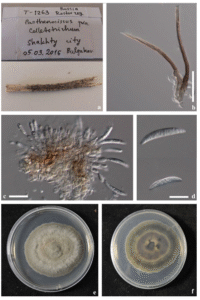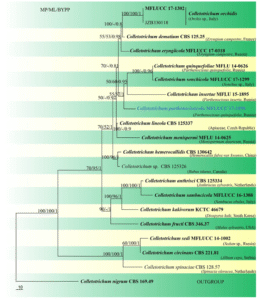Colletotrichum parthenocissicola Jayawardena, Bulgakov, Huanraleuk & K.D. Hyde, sp. nov.
Index Fungorum number: IF 556430; MycoBank number: MB 556430; Facesoffungi number: FoF 05834; Fig. 61
Etymology: The specific epithet parthenocissicola is named after the host genus Parthenocissus from which the taxon was collected.
Holotype: MFLU 16-1557.
Saprobic or weakly pathogenic on dying and dead twigs and petioles of Parthenocissus quinquefolia (L.) Planch (Vitaceae). Sexual morph: Undetermined. Asexual morph: Conidiomata 263–620 μm (x̅ = 437 μm, n = 10) diam, black, acervulus, oval, solitary, gregarious. Setae straight or ± bent, abundant, brown, becoming paler towards the apex, opaque, smooth-walled, septate, 2–4 septate, 58–172 μm long, base cylindrical, 6.5–8.0 μm diam, tip rounded. Conidiophores simple, to 20 μm long, hyaline to pale brown, smooth walled. Conidiogenous cells 8–14 × 2–5 μm (x̅ = 9.3 × 2.5 μm, n = 20), hyaline, smooth-walled, cylindrical to slighty inflated, opening 0.5–1 μm diam, collarette or periclinal thickening rarely observed. Conidia 18–24 × 2–5 μm (x̅ = 20.3 × 3.8 μm, n = 40), L/W = 5.3, hyaline, smooth or verruculose, aseptate, curved, both sides gradually tapering towards the round to slightly acute apex and truncate base. Appressoria not observed.
Culture characteristics: Colonies on PDA flat with entire margin, aerial mycelium sparse and short, pale olivaceous grey, colony surface buff, some sectors dark grey-olivaceous to dark olivaceous grey, iron grey acervuli can be observed mainly on the edge of the colony. Reverse olivaceous green, concentric rings can be clearly observed, reaching 65–70 mm in 7 d at 28 °C.
Material examined: RUSSIA, Rostov region, Shakhty City, private garden, dying and dead twigs and leafstalks of Parthenocissus quinquefolia (L.) Planch. (Vitaceae), 5 March 2016, Timur S. Bulgakov (T-1263, MFLU 16-1557, holotype), ex-type living culture MFLUCC 17-1098.
GenBank numbers: ITS: MK629452; GAPDH: MK639362; CHS: MK639356; ACT: MK639358; β-TUB: MK639360.
Notes: The Colletotrichum dematium species complex is mainly characterized by species with curved conidia (Damm et al. 2009; Jayawardena et al. 2016). C. parthenocissicola falls within the C. dematium species complex clade and forms a separate branch close to C. insertae (Fig. 62). C. quinquefoliae and C. insertae were found on Parthenocissus species in Russia (Li et al. 2015; Hyde et al. 2016). C. parthenocissicola differs from C. insertae in having long setae and conidia (C. insertae L/W = 5.0). The new taxon differs from C. quinquefoliae by having short setae and longer conidia (C. quinquefoliae L/W = 3.0). The cultural of Parthenocissus quinquefolia (L.) Planch. (Vitaceae), 5 March 2016, Timur S. Bulgakov (T-1263, MFLU 16-1557, holotype), ex-type living culture MFLUCC 17-1098. characteristics of these three species cannot be compared as both C. quinquefoliae and C. inserate lack cultures and were described based on sequences. A BLASTn search of NCBI GenBank with the ITS sequence of MFLUCC 17-1098 showed 99–100% similarity to several Colletotrichum species with curved conidia. The closest match in a BLASTn search in GenBank with the GAPDH sequence of MFLUCC 17-1098 showed 99–100% similarity with the species of the C. dematium complex. The CHS sequence showed 99% similarity to C. sonchicola (1 bp difference); the ACT sequence showed a 99% similarity to C. menispermi (2 bp difference), a 98% similarity to C. dematium (3 bp difference) and to C. lineola (3 bp differences) and the β-TUB sequences also showed a 99% similarity to C. dematium (1 bp difference). The newly described taxon differs from its sister taxon C. insertae in 4 bp in ITS, 10 bp in GAPDH, 8 bp in CHS, 11 bp in ACT and 47 bp in β-TUB. C. parthenocissicola differs from C. quinquefoliae in 2 bp in ITS, 73 bp in CHS and 11 bp in ACT and 36 bp in β-TUB. Therefore, a new species is described to accommodate this taxon. Morphological characters as well as phylogenetic evidence support this taxon to be a new species of Colletotrichum.

Fig. 61 Colletotrichum parthenocissicola (MFLU 16-1557, holotype). a Conidiomata on host. b Setae. c Conidiogenous cells. d Conidia e Upper view of the 7 d old culture on PDA. f Reverse view of the 7 d old culture on PDA. Scale bars: b = 50 µm, c–d = 5 µm

Fig. 62 One of the 100 most parsimonious trees obtained from a heuristic search of the combined ITS, GAPDH, CHS, ACT and β-TUB sequence data of Colletotrichum dematium species complex. The tree is rooted with C. nigrum (CBS 169.49). Bootstrap support values (MP and ML) ≥ 50% and Bayesian posterior probabilities ≥ 0.70 are indicated above the nodes. The ex-type strains are in bold. New species in this study is in blue
